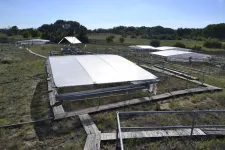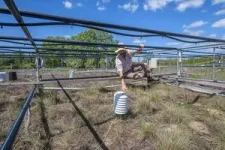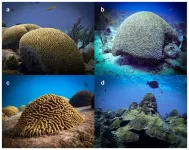(Press-News.org) Predicting and mitigating the effects of climate change while preserving biodiversity is a top priority for both scientists and policymakers. As climate change intensifies, leading to more frequent and severe droughts, understanding the impact on natural ecosystems has become increasingly important. One of the main challenges is forecasting changes in species richness due to shifts in precipitation patterns. While it’s established that, on a broad geographic scale, regions with more water generally support greater plant diversity, results vary at smaller plot levels concerning how rainfall affects species richness. To improve predictions, it’s essential to explore the underlying mechanisms – particularly how intense droughts and long-term rainfall changes impact biodiversity. A new study shows that increased aridity at the plot level is indeed linked to a decrease in plant species richness, and this connection is even more pronounced following extreme droughts. However, this phenomenon is not easy to detect because in the absence of drought, dominant plant species can obscure this effect.
The study, carried out by the HUN-REN Centre for Ecological Research in Hungary, examines the intricate connections between long-term changes in rainfall, extreme drought conditions, the biomass of dominant plant species, and plant species diversity in a dryland ecosystem. Published in the Journal of Ecology, the research reveals that increased dryness leads to a reduction in plant species diversity in drylands and uncovers the mechanisms through which rising aridity contributes to biodiversity loss in these fragile ecosystems.
Using data from a seven-year climate change field experiment, researchers conducted a path analysis to examine how precipitation influences species diversity, both directly and indirectly. The experiment simulated an extreme drought event followed by long-term variations in summer rainfall with the use of rainout shelters. Initial analysis showed a strong positive relationship between rainfall and species diversity after extreme drought treatment, but this effect was absent without drought. Interestingly, the path analysis uncovered another layer: in the absence of drought, increased rainfall boosted the biomass of dominant grass species, leading to a decrease in overall plant diversity. Nevertheless, the direct effect of rainfall remained positive, enhancing species richness even when dominant species exerted a suppressive impact. Additionally, the study revealed that past extreme droughts strengthened the link between rainfall and species diversity. Lead author Dr. Gábor Ónodi explains, “Droughts weaken dominant species, creating opportunities for other plants to thrive, potentially altering the plant community.”
These findings have significant implications for predicting how natural ecosystems will respond to future climate change. Dr. György Kröel-Dulay, the lead researcher of the field experiment, notes “As global temperatures rise and precipitation patterns become more extreme, ecosystems may become increasingly sensitive to changes in water availability.” The study underscores the importance of considering both direct and indirect effects when evaluating the impact of climate change on biodiversity. Senior author Dr. Zoltán Botta-Dukát adds, “By deepening our understanding of these dynamics, we can better anticipate upcoming challenges and develop more effective strategies for conserving biodiversity in a world facing growing environmental uncertainties.”
END
New study reveals how reduced rainfall threatens plant diversity
2025-01-31
ELSE PRESS RELEASES FROM THIS DATE:
New study reveals optimized in vitro fertilization techniques to boost coral restoration efforts in the Caribbean
2025-01-31
A recent study published in PeerJ Life and Environment unveils refined techniques for in vitro fertilization (IVF) in four key Caribbean coral species, offering a crucial advancement in coral reef restoration efforts. Researchers from SECORE International, the CARMABI Foundation, and the University of Amsterdam have developed new insights into the optimal conditions for coral breeding, which could significantly enhance larval production and bolster declining coral populations.
Study Focus
The study examined four broadcast-spawning ...
No evidence that maternal sickness during pregnancy causes autism
2025-01-31
While many studies have reported a link between a mother’s health condition during pregnancy and her child’s risk of autism, a new study shows that nearly all of these “associations” can otherwise be explained by factors such as genetics, exposure to pollution, and access to healthcare.
Led by researchers at NYU Langone Health, the study revealed that, of the few conditions truly associated with autism, all were actually complications with the fetus — leading the authors to believe ...
Healthy gut bacteria that feed on sugar analyzed for the first time
2025-01-31
A microbe found in the lower part of the gut that is associated with good health has been comprehensively analysed and found to have a focused diet breaking down sugars locked away in mucus..
The new study, published in Nature Microbiology today (Friday 31 January) is a complete systematic analysis of how the human colonic beneficial microbe, Akkermansia muciniphila (AM) feeds on types of sugar found in the mucus secreted in the digestive system. The study focused on 66 enzymes that the AM microbe uses to break down mucus that is an essential part of the mucus layer that lines the human ...
240-year-old drug could save UK National Health Service £100 million a year treating common heart rhythm disorder
2025-01-31
A 240-year-old drug called digoxin could save the National Health Service (NHS) at least £100 million each year when treating older patients with atrial fibrillation and heart failure. This was compared to usual treatment with a beta-blocker according to a new study from the University of Birmingham, the city where digoxin was first used in 1785.
In a paper published in the journal Heart, researchers conducted an economic analysis on a clinical trial called RATE-AF to look at the differences between two widely used drugs for older patients with a common heart rhythm disorder called atrial fibrillation (AF) and symptoms ...
Detections of poliovirus in sewage samples require enhanced routine and catch-up vaccination and increased surveillance, according to ECDC report
2025-01-31
Between September and December 2024, four countries in the EU/EEA (Finland, Germany, Poland, Spain) and the United Kingdom reported detections of circulating vaccine-derived poliovirus type 2 (cVDPV2) in sewage samples. This is the first time cVDPV2 has been detected in EU/EEA countries from environmental surveillance.
To date, no human polio cases have been reported and the EU/EEA continues to be polio-free, but such findings call for increased vigilance.
Laboratory analyses likely indicate that the virus has been repeatedly introduced from an unknown area where that specific form of the virus is still in circulation. These recent importations may pose a threat to public ...
Scientists unlock ice-repelling secrets of polar bear fur for sustainable anti-freezing solutions
2025-01-31
Polar bear fur’s natural ability to resist ice formation could pave the way for safer, more sustainable solutions to prevent ice buildup across industries such as aviation and renewable energy, according to researchers at the University of Surrey.
An international study published in Science Advances has explored the anti-icing properties of polar bear fur in extreme Arctic conditions, revealing a unique mix of lipids in the fur’s sebum – an oily substance produced by the skin - that drastically reduces ice adhesion. ...
Ear muscle we thought humans didn’t use — except for wiggling our ears — actually activates when people listen hard
2025-01-31
If you can wiggle your ears, you can use muscles that helped our distant ancestors listen closely. These auricular muscles helped change the shape of the pinna, or the shell of the ear, funneling sound to the eardrums. Millions of years ago, our ancestors stopped using them, so humans’ auricular muscles are only vestigial. But now scientists examining the function of these muscles have discovered that they activate when we’re trying to listen to competing sounds.
“There are three large muscles which connect the auricle to the skull and scalp and are important for ear ...
COVID-19 pandemic drove significant rise in patients choosing to leave ERs before medically recommended
2025-01-31
Researchers have long known that patients who leave emergency departments before medically advised use more emergency care services, are more likely to be readmitted to the hospital and face higher costs of care—as well as increased mortality rates.
Until now, however, little has been known about national, multi-year trends, including the impact of the COVID-19 pandemic on this phenomenon.
“In addition, most studies have focused on specific subgroups of patients, such as those with stroke or those with appendicitis who leave after surgery,” said Elena Andreyeva, PhD, a faculty member with the Texas A&M University School of Public ...
Burn grasslands to maintain them: What is good for biodiversity?
2025-01-31
As grasslands get abandoned, controlled burning is discussed as a labor-saving method of keeping forests at bay. A Kobe University research team found that this method results in higher biodiversity and a higher prevalence of endangered plant species in some grasslands compared to others, depending on what soils they grow on.
Humans have been keeping grasslands since millennia by grazing, mowing and controlled burning, all of these are means to keep forests from overgrowing the grasslands. Grazing and mowing are, however, labor intensive and as rural areas become increasingly depopulated, grasslands have been disappearing worldwide. One consequence ...
Ventilation in hospitals could cause viruses to spread further
2025-01-31
Increased use of ventilation and air cleaners, designed to mitigate the spread of viral infections in hospitals, is likely to have unpredictable effects and may cause viral particles to move around more, according to a new study from researchers at UCL and UCLH.
In the study, published in Aerosol Science & Technology, researchers investigated the effect of using built-in mechanical ventilation and portable air cleaners (PACs)1 upon the spread of airborne particles, which are similar to those breathed ...




